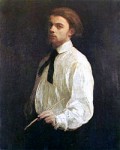
Henri Fantin-Latour
French, 1836-1904
Roses, 1884
oil on canvas
Michael Armand Hammer and the Armand Hammer Foundation
Looan

Henri Fantin-Latour, Self-portrait, 1859, Museum of Grenoble
"I tried to make a painting representing things as they are found in nature; I put a great deal of thought into the arrangement, but with the idea of making it look like a natural arrangement of random objects. This is an idea that I have been mulling over a great deal; giving the appearance of a total lack of artistry." - Henri Fantin-Latour
COMMENTS
The systematic nature of Fantin’s technique in these flower-pieces does in fact begin to get the better of him from about 1880 onwards. It is generally agreed that the examples painted towards the end of his life have a mechanical dryness which makes them inferior to the work he did earlier. That Fantin should have deteriorated in this way towards the end of his career demonstrates, perhaps, his feeling that he should now go back to more imaginative kinds of work. It may also show his loosening grip on a reality which he had always had difficulty in confronting. But finally it may also be a criticism of Fantin’s particular type of pictorial objectivity. It is not the objectivity of a Géricault, who can take a pile of severed human limbs and make them the subject of a still-life which has a profound comment to make both upon the nature of pictorial representation and on mortality itself. Rather, there lies in the heart of Fantin’s approach a kind of indifference to what he is depicting. It is as if the beauty of the blooms he paints is a kind of obstacle to be overcome. Nature must be sacrificed to the higher course of art. The aloofness of Fantin’s still-lifes and flower paintings can make them, in the examples where technique itself has been allowed to become routine, both trivial and boring as works of art. But when he is painting at his best the spectator is aware of, and is stimulated by, the combination of care and relish which has gone into the weaving of the infinitely complex web of marks from which the image has been created.
- Edward Lucie-Smith, Henri Fantin-Latour, Phaidon Press, 1977
